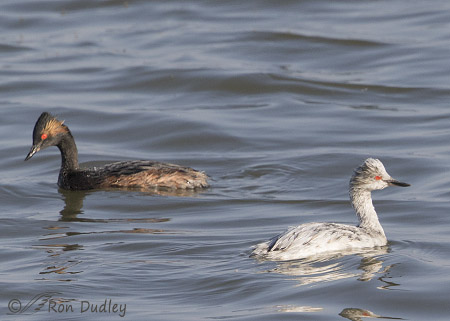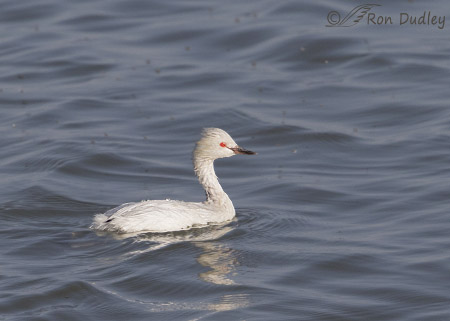I photographed eight Leucistic Eared Grebes in 14 minutes yesterday morning and at least one more later on.
- Prepare yourself to be disappointed by the small size of these images. As I mentioned yesterday we’re having problems with our server so in order to “lighten the load” I’m trying to limit my posts to a single image until we get it resolved. I wanted to post at least two photos today so both of these images are only half their normal size (450 pixels on the long side instead of 900). The birds weren’t very close and these photos have been heavily cropped so you’re not missing much detail…
Leucism in birds is the lack of normal pigments in feathers and may be indicated by a single white feather, all of them being white, or anywhere in-between. Leucistic birds have normal colored eyes, legs, feet and any other bare part (leucistic individuals are not albinos).
Others have reported the occasional leucistic Eared Grebe along the causeway in past years but since I’m generally not one to chase rarities I’d never photographed one until yesterday. When we spotted our first one on the north side of the causeway I was close to being flabbergasted but when we kept finding and photographing more of them every couple of hundred yards or so I couldn’t believe my eyes. They weren’t close enough for good detail in my photos (photographing from the elevated road) but each one we saw was actually quite close to the shore.
The bird on the right is one of the leucistic grebes. The other one is typical of what almost all of the other hundreds of thousands of Eared Grebes on the lake look like right now – many of them are transitioning out of breeding plumage while they’re here. The leucistic grebes I photographed yesterday morning varied from almost pure white to significantly darker than this bird but there was no question that each of them was leucistic. In each case the contrast with typical grebes was dramatic.
This was one of the grebes that was very nearly pure white.
The incidence of leucism in Eared Grebes varies but it’s always low. One comprehensive study of Eared Grebes on Mono Lake in CA summarized their results as follows:
- “Frequency of leucism. – Leucistic birds were rare among spring migrants (Table 3). I saw none among ca. 42,000 birds counted in March-May in 198 1, 1982, 1983; in May, 1984, two were seen among ca. 26,000 grebes. I estimated that they were no more common than 1:15,000-20,000 at this season. In summer (June-July), they were much more conspicuous. In 198 1, 1982, and 1984, I determined a ratio of ca. 1:5,000-8,000, but in 1983, there were at least 13 in a summering population of 6,000 (1:460)”.
I have no idea why we found so many leucistic grebes in such a short time and in such a small area. The first time I drove that approximate two miles we found at least eight of them. We were so excited we turned around and did it again and I’m convinced there were several more leucistic individuals that time but the coloration of some of them was so similar I’m not sure of an exact count.
For bird lovers these are exciting times along the causeway.
Ron




Great shots and I have never heard of that many lecucistic birds in one area before. I thought they had a difficult time surviving. That’s amazing!
Charlotte
How exciting. I haven’t seen any. Hope one day I do. Thanks Ron!
I hope you do too, Jean.
Flabber and ghasted. Gob and smacked. What an incredible thing to see.
As I said to Mia, my ‘wonder why’ button would be in overdrive, wondering whether it is a genetic or environmental anomaly. Or a combination. And hoping that the apparent good health of this collection continues.
Thank you, EC.
Interesting to see so many. Aside from vulnerability to predators, one of the main problems would be increased potential for feather wear or breakage. The melanin provides extra strength to the feathers and the production of melanin often causes an increase in the amount of keratin produced. The result is a feather that is stronger, more resistant to the chewing of feather lice and degradation by keratin-eating bacteria. This is especially important in the flight feathers. Note that the flight feathers of long-distant migrants are black (like Snow Goose, Western Tanager, Black-headed Grosbeak, and many, many more). American Pelicans have black flight feathers. Of course, there are exceptions like egrets. But these are usually short-distant migrants that move in short hops, not one long flight. Albino or mostly leucistic hummingbirds, frigatebirds, swifts and others that spend most of their time in the air can often not survive their first year to reach their first full molt. The friction of the air simply wears the feathers so much that the bird becomes flightless before reaching the first molt. Friction with the air will not be as much of a problem for these grebes since they spend so little time in the air.
As for eye color, I’m not so sure that albino grebes would have pink eyes. In albinos, the lack of melanin in the eye allows blood to be seen, resulting in pink. I don’t know the source of eye color in grebes (less is understood about eye color than coloration of any other part of the body in birds), but I suspect it may be a pterin as these pigments are often responsible for bright red, orange or yellow in the eyes of birds. If so, the production of this pigment is independent from melain. Their could be a lack of melanin production while still producing pterin resulting in red eyes not pink. In any case, these are fascinsating birds and thanks for sharing this with us.
Very interesting info you’ve provided for us, Dan. Thank you.
I will have to go out in the am Sunday the light was very hazy by the time I drove by today. I hope your incredible find is still floating near by. Where there still huge flocks of Phalaropes too?
There were still seemed to be lots of Phalaropes, April, but to be honest after we started looking for leucistic grebes close to shore I didn’t pay much attention to the birds further out.
Very interesting-looking birds, but whether their coloration is “normal” or leucistic, Grebes’ eyes are just dazzling! Or bizarre, I’m not sure which — they look lit-up from within.
Thanks for the post, Ron … wishing you soon-resolved server problems! How annoying.
Chris, I’ve read that the red eyes of some grebe species improve their vision underwater. Not positive it’s a proven fact though…
Intersting thst you eoukd see so msny….I wonder how sound their general health is. I echo Dick’s comments…
“I wonder how sound their general health is”
All nine of these birds looked perfectly healthy to me, Patty.
With leucistic Eared Grebes, it’s easy to see why people might think the pure white one was albino – given that an albino would have pink eyes and the red is seemingly not that far off from pink (never mind the dark beak). The pictures may be small but they still tell the story. Hope your server issues are resolved soon.
I hope so too, Susan. Thanks.
Very interesting-quite a stunning contrast with that ruby-red eye coloration……..how would an albino grebe differ in appearance from a leucitic one ?
Kris, one of the main differences is that a true albino would have pink eyes instead of the normal ruby red eyes.
Looks like this gene pool could use a lifeguard. 😉 Interesting that this group can support so many leucs. Great shots — love what the movement of the water is doing to the reflections. Hope you guys get your server issues worked out soon; I know how frustrating that can be!
Interesting first sentence, Marty.
I’m tired of this damned server stuff!
WOW! Must be the genetics of this group……….. I’m guessing they would be more vulnerable to predators being white. Hope the server issue gets handled soon. 🙁
I suspect they would be more vulnerable, Judy.
Neat! It looks like the leucitic mutation within this group of Grebes is being passed on successfully!
I wonder what that will do for their survival rate? Being whitish they will standout against water or grass?
Interesting post.
Good luck with the server!!!
Thanks, Dick, It’s my understanding that being leucistic is a disadvantage for them in more ways than one.
Usually the feathers are weaker and wear faster than they molt.